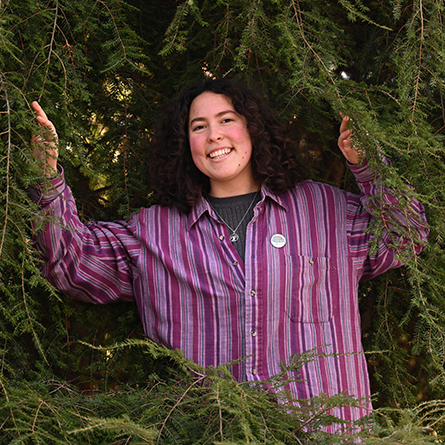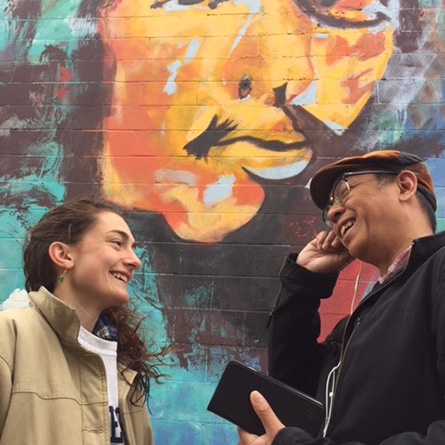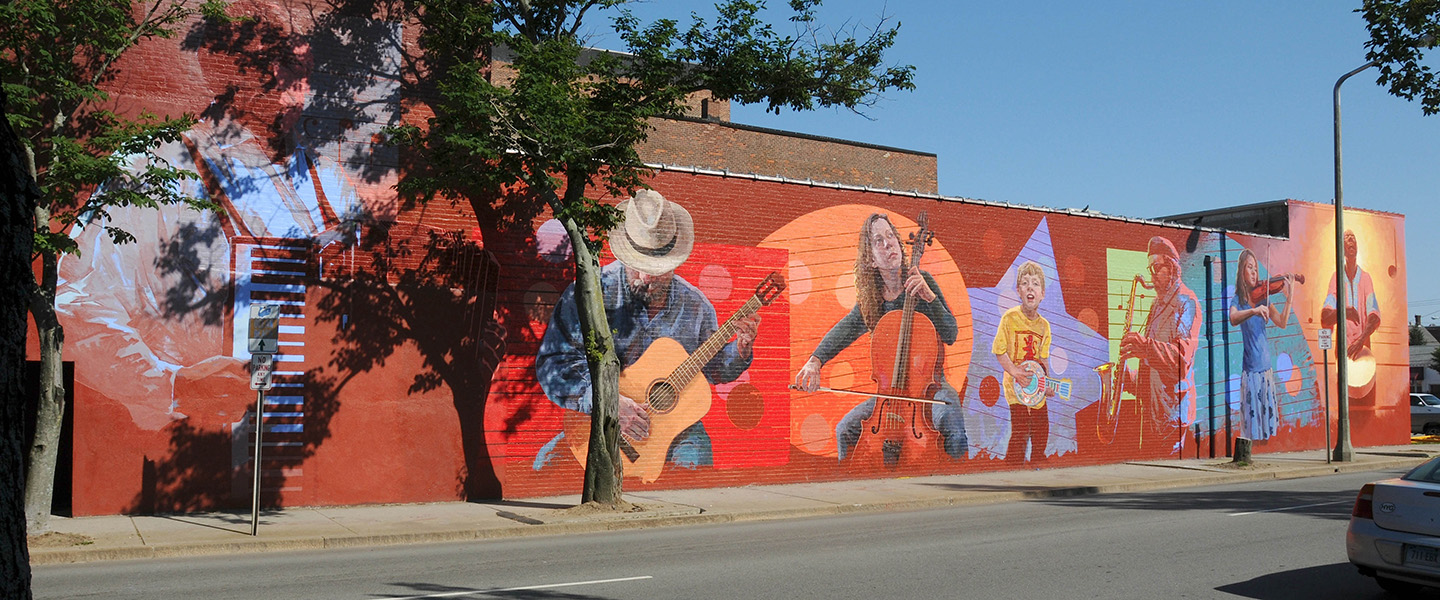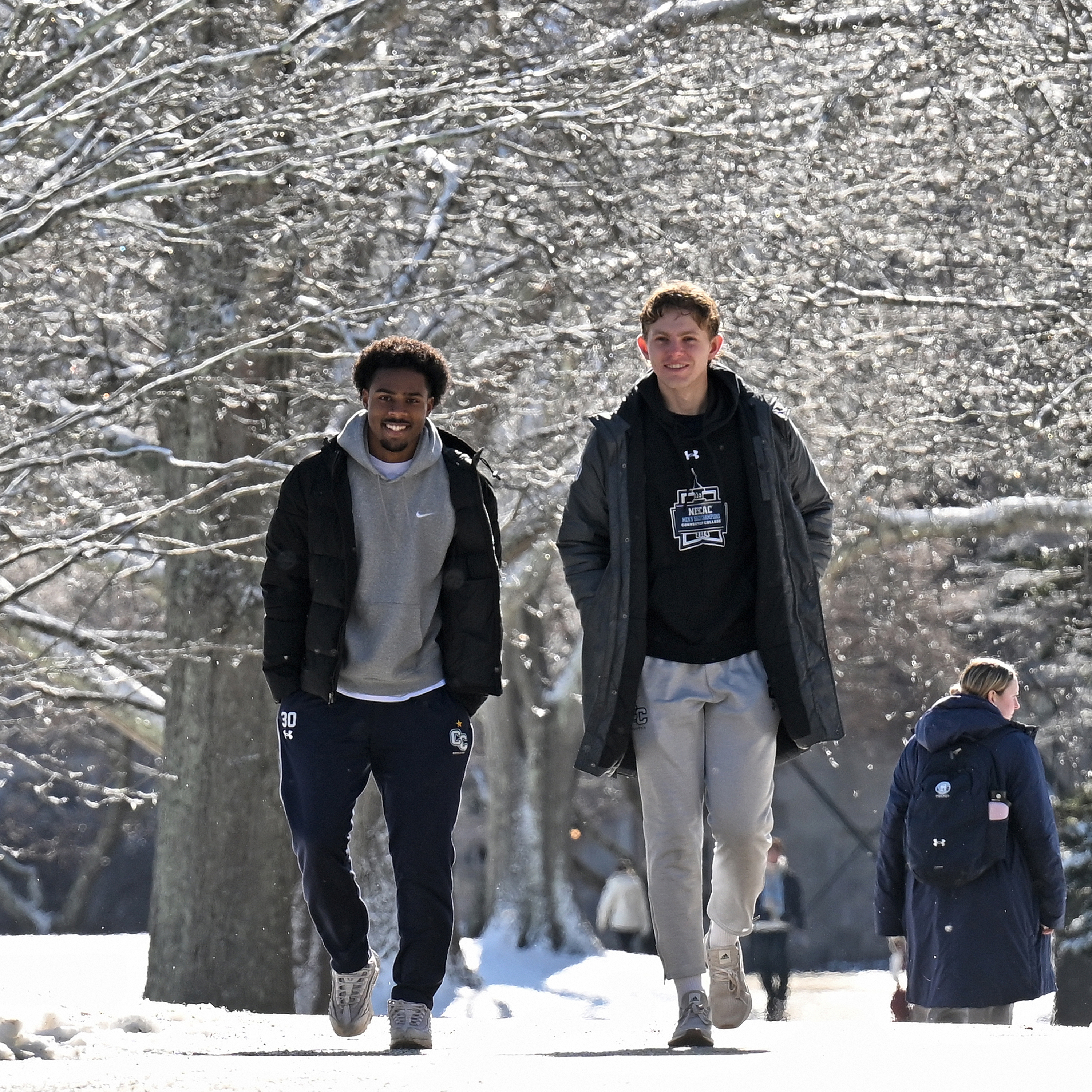
Camel Tours
A free web application developed by Conn faculty and students uses multimedia to enrich cultural landmarks.

A mural in downtown New London depicting a brilliant underwater scene is a nod to New London’s maritime past—but it is also a tribute to artist Michael McNabney’s father.
McNabney explains the origins of the mural in an interview conducted by Virginia Gresham ’17 that is accessible to anyone visiting the mural with a cell phone in hand. By scanning a QR code, visitors gain access to the interview, as well as photos of the mural in development.
“My father was a Navy diver—a hard hat diver is what they called them, and I wanted to memorialize his service at some point in my life, since he’s long deceased,” McNabney says as part of the “Wall to Wall: Streetside With New London Mural Walk Artists” project produced by Gresham for her senior integrative project through the Ammerman Center for Arts and Technology.
McNabney developed the “Hard Hat Painters” mural on the facade of the Carriage House building with New London artist Troy Zaushny in 2012 for the state’s City Canvases initiative. The mural is part of Hygienic Art’s Wall to Wall Mural Walk, which recently expanded to include exclusive interviews with artists, and production photos, thanks to Gresham’s initiative.
Gresham used a web application called CamelTours, developed at Connecticut College by faculty and students, to enhances the experience of someone touring the murals. She interviewed artists and contributors, and collected dozens of behind-the-scenes photos of each mural, which she then uploaded to the CamelTours.org site.
Thanks to Gresham’s work, mural walk patrons can now hear directly from the artists as they explore the 24 murals throughout downtown New London.
The audio and visual elements provide an added dimension that goes beyond static signage most commonly used on tours of cultural landmarks. As a result, Gresham helped produce the largest cohesive mural walk in New England, and the only one known to be enhanced with a web application.
“I wanted to engage with the community, continue to develop CamelTours technically, further CamelTours’ mission to empower communities to tell their own stories, and for the project to last in perpetuity,” Gresham said. “Artists’ voices and stories are now being heard by visitors and locals alike.”
Enhancing the experience of walking tours—whether of historic buildings, old cemeteries, public art, or public gardens—was just one of the goals that drove the creation of CamelTours about five years ago.
The CamelTours app was born in the spirit of interdisciplinary work at Connecticut College. Its development brought together Anthony Graesch, associate professor of anthropology, and Christine Chung, the Jean C. Tempel '65 Associate Professor of Computer Science, who sought a vehicle for faculty-student research in open source software.
“The beauty of a liberal arts education is we don’t have to exist in silos—we can start to break down these false boundaries between disciplines,” Graesch explained. “In this case we asked, what do anthropology and computer science have in common?”
The app enriches the experience of taking in cultural landmarks and sites, but it is also meant to be used and adapted by anyone.
“We wanted to develop the software by which anyone with browser access, and a smartphone to record audio and take photos, could create a media-rich tour to tell their stories and history,” Graesch said. “The idea was to move beyond static signage. It’s a dynamic way of telling stories that gives voice back to local communities.”
One of the first CamelTours was developed by Glenn Dreyer, the Charles and Sarah P. Becker '27 Director of the Arboretum, and adjunct associate professor of botany. Dreyer used the open source software to record details of notable sites within Conn’s Arboretum, and uploaded historic photos. Signs were designed with QR codes so that the audio-visual tour could be easily accessed and downloaded by users.
“It’s another way to get our message out there and enrich people’s visiting experience,” Dreyer said. “For instance, with Buck Lodge, someone visiting might ask, ‘why is it there? What was it used for?’”
Gresham also sees CamelTours as a vehicle to empower communities.
“Camel Tours provides a venue for first-person narratives and enables communities to voice their own stories,” Gresham said. “This is a social justice issue because it is a way of addressing disparities in resource access.”
May 30, 2017

